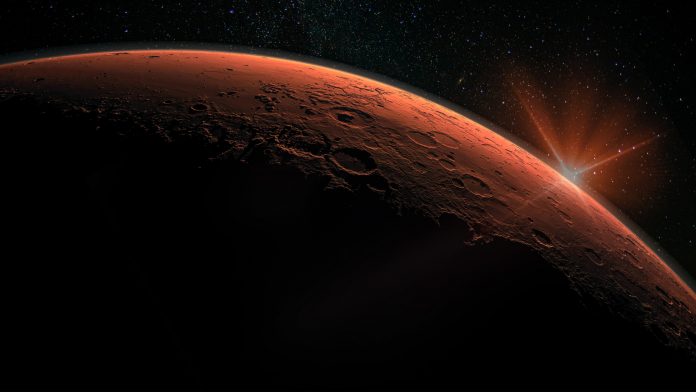The Planetary Science Group has examined the dynamics of a peculiar ice cloud on Mars that could be up to 1,800 km long and 150 km wide.
The ice cloud stretches out quickly before vanishing within a few hours in a fast daily cycle that is repeated every morning for a period of several months.
This research has been highlighted by the European Space Agency.
When spring comes in southern Mars, a massive ice cloud appears near the 20 km-high Arsia Mons volcano. At its greatest, the cloud is approximately 1,800 km long and 150 km wide. It emerges when the volcano obstructs the wind; air is pushed up its sides and transports moisture which, on cooling, ultimately forms an orographic cloud. The uniqueness of this orographic cloud is that once it has been developed – at a height of 45 km – the wind carries it along, resulting in its swift expansion at a speed of about 600 km/h. It grows so rapidly that in just two or three hours, the largest orographic cloud ever seen on Mars has been developed.
The cloud endures a fast daily cycle that replicates itself each morning over a period of several months. It begins expanding before dawn, grows quickly, then ceases to grow, breaking away from its previous location and finally evaporates in the later part of the morning when the rising sun results in an increase in air temperature.
The cloud’s daily cycle was discovered by scientists at the UPV/EHU’s Planetary Science Group in partnership with scientists from other countries. They were able to locate it with a combination of the pictures taken by several cameras, featuring new observations produced with a small camera on board of the ESA Mars Express probe, a long-running Mars exploration mission that has been in orbit since 2003.
The ice cloud is challenging to examine in its totality due to the swift changes in the dynamics of the Martian atmosphere and the restrictions in the orbit of many spacecrafts.
“To overcome these obstacles, we are using one of the Mars Express instruments: The Visual Monitoring Camera (VMC),” explained Jorge Hernández-Bernal, predoctoral researcher in the Planetary Science Group and lead author of the study.
“Many Martian orbiters cannot even observe this part of the planet’s surface until early afternoon, due to the characteristics of their orbits, so this is the first detailed exploration of this interesting phenomenon, something possible not only thanks to the diversity of the Mars Express instruments, but also to its orbit,” added Agustín Sánchez-Lavega, a UPV/EHU professor, co-author of the study and VMC science team lead.
“Although orographic clouds are frequently observed on Earth, they do not attain this enormous length nor have such changing dynamics. Understanding this cloud gives us an excellent opportunity to try to replicate its formation with models that will improve our knowledge of climate systems on both Mars and Earth,” he concluded.









